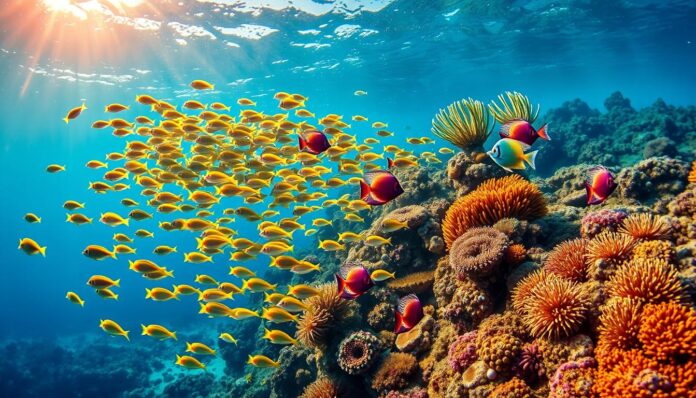Did you know that the regal damselfish can challenge fish up to 15 times its own size? This tiny marine warrior has been making waves in tropical underwater ecosystems. It has changed how scuba diving enthusiasts explore coral reefs.
Scuba diving with damselfish offers an extraordinary tropical vacation experience. These vibrant creatures, ranging from 7 to 31 centimeters in length, live in diverse marine environments across the Eastern Pacific Ocean.
When you dive into their world, you’ll see remarkable fish with brilliant colors. They are known for their unexpected territorial behavior. The damselfish population has been growing fast. Sightings now range from Mexico’s Yucatan Peninsula to the Florida Panhandle, making it exciting for marine explorers.
Key Takeaways – Diving with Damselfish
- Damselfish are small yet aggressive marine creatures
- Tropical scuba diving offers unique wildlife encounters
- Damselfish inhabit diverse reef environments
- These fish play critical roles in marine ecosystems
- Underwater photography can capture their remarkable behaviors
Introduction to Scuba Diving and Damselfish
Diving into the vibrant world of coral reefs is exciting. It’s full of life. Damselfish, small but dynamic, are key players in these ecosystems.
What Makes Damselfish Special?
Damselfish are unique in the ocean. They have:
- Vibrant colors like electric blue and bright yellow
- Compact size, usually 3-4 inches long
- Incredibly territorial behavior
- Remarkable adaptability to different reef environments
Habitat of Damselfish
These fish live in warm tropical waters, mainly in coral reefs. Lagoon damselfish like shallow waters in the Indo-Pacific. They make homes in coral structures.
“In the underwater realm, damselfish are the tiny warriors of their coral kingdoms” – Marine Biologist Research Team
Importance in Marine Ecosystems
Damselfish are vital for reef health. They “farm” algae patches near their homes. This helps keep the ecosystem balanced. Their territorial and feeding habits support the reef’s health.
| Characteristic | Details |
|---|---|
| Average Length | 3-4 inches |
| Primary Habitat | Tropical Coral Reefs |
| Diet | Plankton, Algae, Small Invertebrates |
Preparing for Your Dive
Diving into the vibrant world of damselfish requires careful preparation and the right equipment. Whether you’re a novice or an experienced underwater explorer, understanding the essentials of scuba certification and dive gear rental is key. It ensures a safe and exciting marine adventure.
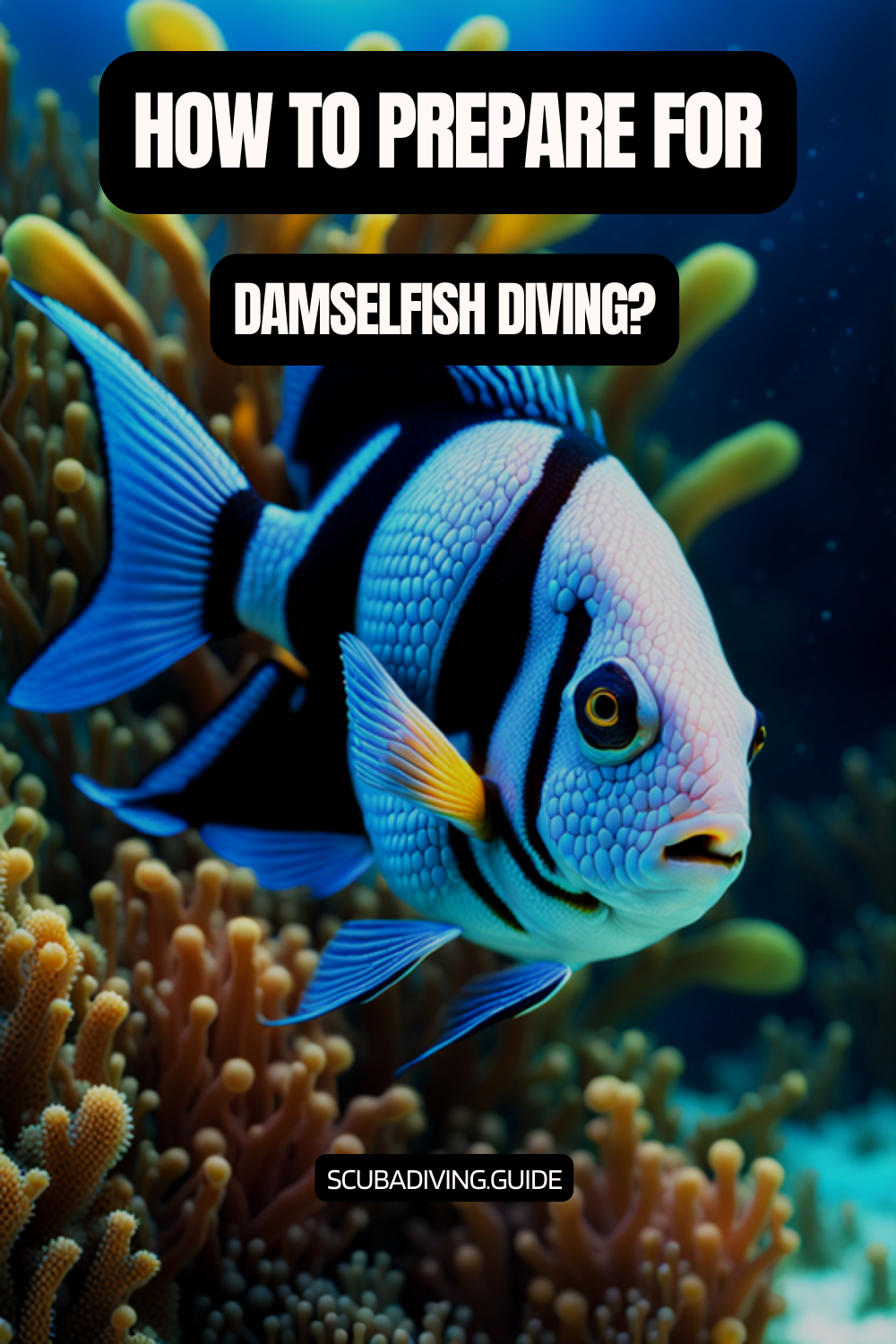
Essential Scuba Gear for Your Underwater Journey
Before diving into tropical waters, make sure you have the right scuba gear. Most dive centers offer dive gear rental options. This makes it easy for travelers who don’t want to carry heavy equipment.
- Mask and snorkel
- Wetsuit or dive skin
- Fins
- Buoyancy Compensator Device (BCD)
- Regulator set
- Dive computer
Safety First: Diving Preparation Tips
Getting proper scuba certification is not just recommended—it’s essential. Professional training teaches you important safety protocols and underwater navigation techniques.
“Preparation is the key to an unforgettable underwater experience.” – Professional Diving Instructor
Critical Safety Recommendations
- Complete a recognized scuba certification course
- Practice emergency skills regularly
- Always dive with a buddy
- Check equipment before each dive
- Monitor air consumption carefully
Divers should know that visibility in tropical waters can be 20 to 30 meters. This provides great conditions for observing marine life like damselfish. With proper scuba certification and well-maintained dive gear rental, you’ll be ready for an incredible underwater adventure.
Where to Find Damselfish
Exploring the underwater world of damselfish needs careful planning. They live in various marine habitats. This makes them exciting for scuba diving fans.
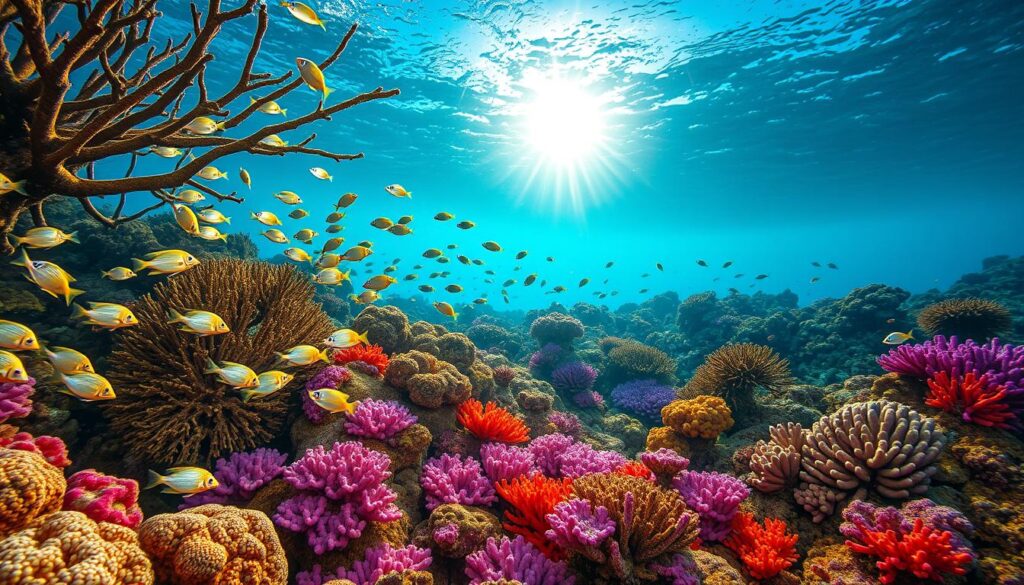
Damselfish are found in the Atlantic and Indo-Pacific oceans. Their ability to adapt makes them interesting to divers.
Popular Diving Destinations
Some top spots for damselfish include:
Asia:
- Maldives: The Maldives is renowned for its pristine coral reefs and abundant marine life. Dive sites such as North Male Atoll and South Ari Atoll offer excellent opportunities to encounter damselfish, along with a wide array of other colorful reef fish.
- Indonesia: With its vast archipelago, Indonesia boasts numerous world-class dive sites. Raja Ampat, Komodo National Park, and Bunaken Marine Park are just a few destinations where you can explore thriving reef ecosystems and encounter damselfish in their natural habitat.
- Egypt: The Red Sea in Egypt is a diver’s paradise, known for its crystal-clear waters and diverse marine life. Destinations like Sharm El Sheikh, Hurghada, and Marsa Alam provide exceptional diving opportunities to observe damselfish, along with stunning coral formations and other marine species.
- South Africa: The waters along the coast of South Africa offer diverse diving experiences. Sodwana Bay, Aliwal Shoal, and the Protea Banks are renowned for their rich biodiversity, including damselfish. These locations also provide the chance to encounter larger marine species, such as sharks and rays.
- Bonaire: Bonaire, part of the Dutch Caribbean, is famous for its pristine marine parks and protected reefs. The island offers abundant opportunities to observe damselfish in their natural habitat, along with a wide variety of colorful reef fish and vibrant coral formations.
- Cayman Islands: The Cayman Islands, including Grand Cayman, Cayman Brac, and Little Cayman, are renowned for their crystal-clear waters and diverse marine life. The colorful reefs surrounding the islands are home to damselfish, along with other species such as parrotfish, angelfish, and turtles.
- Belize: Belize is home to the renowned Belize Barrier Reef, a UNESCO World Heritage Site. Diving destinations like the Blue Hole, Turneffe Atoll, and Lighthouse Reef offer breathtaking encounters with damselfish, as well as a plethora of other marine species, including nurse sharks and eagle rays.
- Honduras: The Bay Islands of Honduras, including Roatán, Utila, and Guanaja, boast vibrant coral reefs and an abundance of marine life. Damselfish can be spotted among the colorful coral formations, along with other reef fish, turtles, and rays.
- Red Sea (Egypt): The Egyptian Red Sea, previously mentioned in the Africa section, is also accessible from Europe. European divers often choose to visit this region for its extraordinary underwater landscapes, diverse marine life, and the chance to encounter damselfish and other tropical species.
- Great Barrier Reef (Australia): The Great Barrier Reef is the world’s largest coral reef system, stretching along the coast of Queensland, Australia. This iconic destination offers incredible diving opportunities to witness damselfish amidst a kaleidoscope of coral formations and a vast array of marine species.
- Fiji: Fiji is known for its pristine waters and vibrant coral reefs. Diving around the islands of Taveuni, Beqa Lagoon, and the Bligh Waters provides ample chances to observe damselfish alongside other colorful reef inhabitants.
- Florida Keys (USA): The Florida Keys are renowned for their stunning coral reefs and diverse marine life. John Pennekamp Coral Reef State Park and the Florida Keys National Marine Sanctuary offer exceptional diving experiences, where damselfish can be spotted along with other tropical fish species.
- Galapagos Islands (Ecuador): The Galapagos Islands are a UNESCO World Heritage Site and a bucket-list destination for divers. The unique marine ecosystems around the islands are home to an impressive array of marine species, including damselfish. Diving here provides a once-in-a-lifetime opportunity to witness these fascinating fish in their natural habitat.
- Fernando de Noronha (Brazil): Located off the coast of Brazil, Fernando de Noronha is an archipelago known for its pristine waters and rich marine biodiversity. Dive sites around the islands offer the chance to observe damselfish, as well as sea turtles, rays, and a variety of tropical fish.
These destinations represent some of the best locations for diving with damselfish across the globe. Each region offers its unique underwater landscapes, diverse marine life, and memorable encounters with these captivating fish. Whether you choose to explore the vibrant reefs of the Caribbean, the pristine waters of the Maldives, or the breathtaking beauty of the Great Barrier Reef, diving with damselfish will leave you with unforgettable memories of the underwater world.
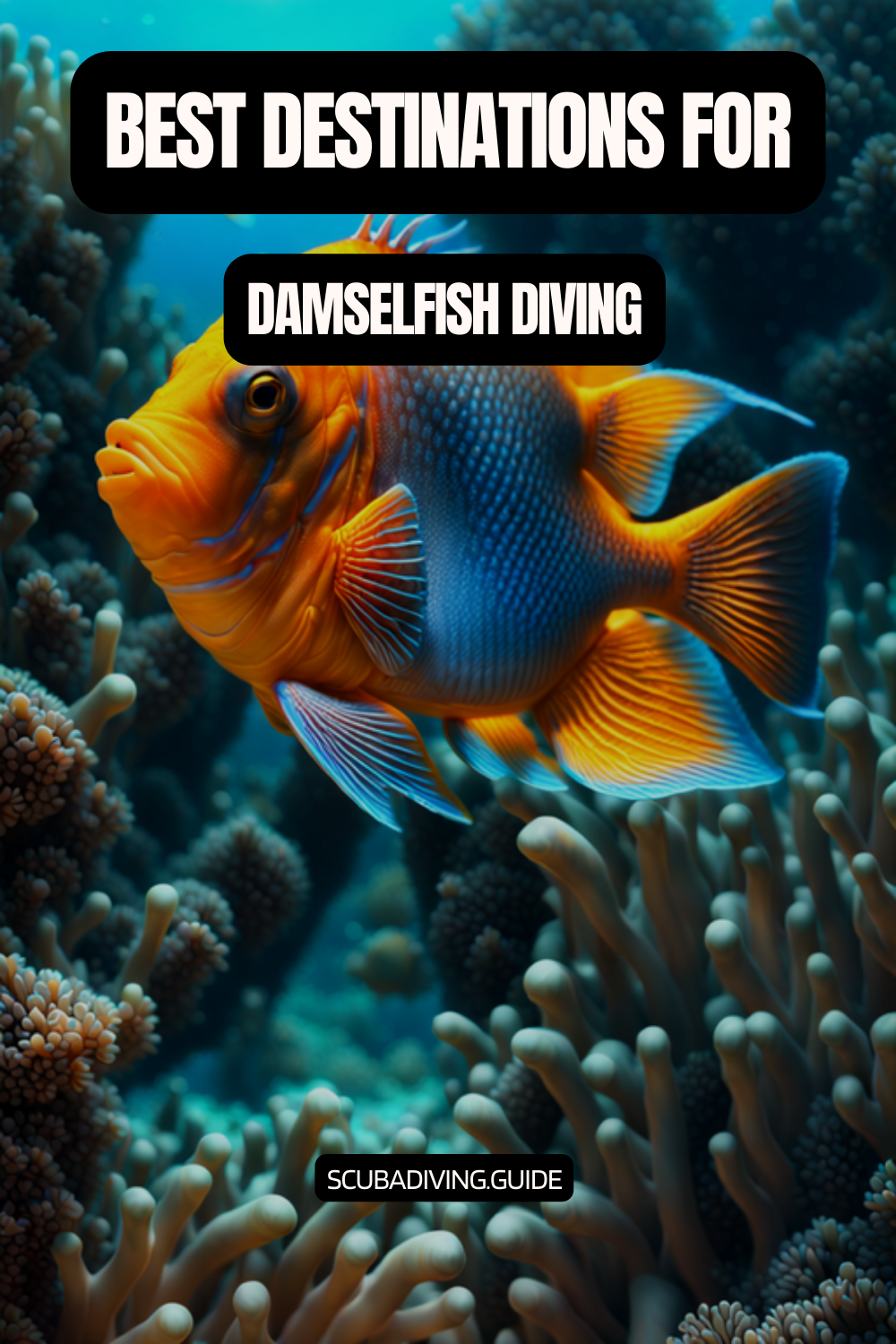
Diving Depth and Species Distribution
Divers can find damselfish at depths of 2 to 15 meters. There are about 18 different species in the best spots.
| Damselfish Species | Maximum Length | Typical Habitat |
|---|---|---|
| White Damselfish | 19 cm | Coral reefs |
| Blue Damsel | 11 cm | Rocky areas |
| Yellowtail Damselfish | 11 cm | Tropical marine zones |
Best Time to Dive
For the best damselfish views, go on liveaboard cruises during the dry season. This time offers clear water and access to damselfish-rich areas.
Pro tip: Juvenile damselfish often display more vibrant colors, making them photogenic underwater subjects.
Plan your trip for the best marine visibility. This way, you’ll have amazing damselfish encounters.
The Experience of Diving with Damselfish
Diving into the underwater world of damselfish is an unforgettable snorkeling adventure. These tiny but fierce fish show us the beauty of coral reefs. They give us a peek into the complex world of marine life.
What to Expect Underwater
Exploring coral reefs, divers will find damselfish. These small but territorial fish create exciting scenes. They are a favorite among underwater photography fans.
- Observe damselfish defending their small territories
- Watch for quick, darting movements around coral formations
- Expect occasional aggressive displays towards intruders
Visual Splendor of Damselfish
With over 300 species worldwide, damselfish show incredible diversity. Most species live between 2 to 15 meters deep. This offers divers a chance to see colors rarely seen in other marine places.
“The damselfish may be small, but their personality is larger than life!” – Marine Biologist
Underwater photographers will love their bright colors and patterns. From the Blue Damsel to the Yellowtail Damsel, each species is unique. They make every snorkeling trip unforgettable.
- Blue Damsel: Vibrant blue coloration
- Yellowtail Damsel: Striking yellow tail
- Three Spot Domino Damselfish: Distinctive spot patterns
These tiny creatures turn underwater landscapes into living art. Each dive is a special journey into nature’s design.
Understanding Damselfish Behavior
Diving into the world of marine life, we find damselfish fascinating. These small creatures are key to coral reef health. They show complex social structures and defense tactics that thrill underwater explorers.
Social Structure and Group Dynamics
Damselfish have unique social traits in the sea. With over 250 species, they have interesting ways of reproducing:
- Some species can change gender throughout their lifetime
- Males may transform into females when the existing female disappears
- Groups typically range from 12 to 20 individuals
“The social world of damselfish is a dynamic and complex ecosystem within itself.” – Marine Biologist Dr. Elena Rodriguez
Territorial Defense Mechanisms
Encounters with damselfish show their fierce territorial behavior. These small defenders of the reef have amazing defense strategies:
- Aggressive confrontations with intruders
- Defending areas up to ten times their body size
- Protecting critical algae farming territories
The Stegastes planifrons, or Three-spot Damselfish, is a perfect example. At just three to four inches long, they bravely face larger sea creatures to guard their territory.
Ecological Significance
Damselfish are more than just territorial fighters. They are vital to the ecosystem. They “farm” algae, helping coral reefs stay healthy and balanced. Their work keeps the reef’s delicate ecosystem in check.
Photography Tips for Capturing Damselfish
Underwater photography is a thrilling challenge for dive enthusiasts. It lets them capture the vibrant world of damselfish. With the right gear and techniques, they can immortalize these fascinating creatures in their natural home.
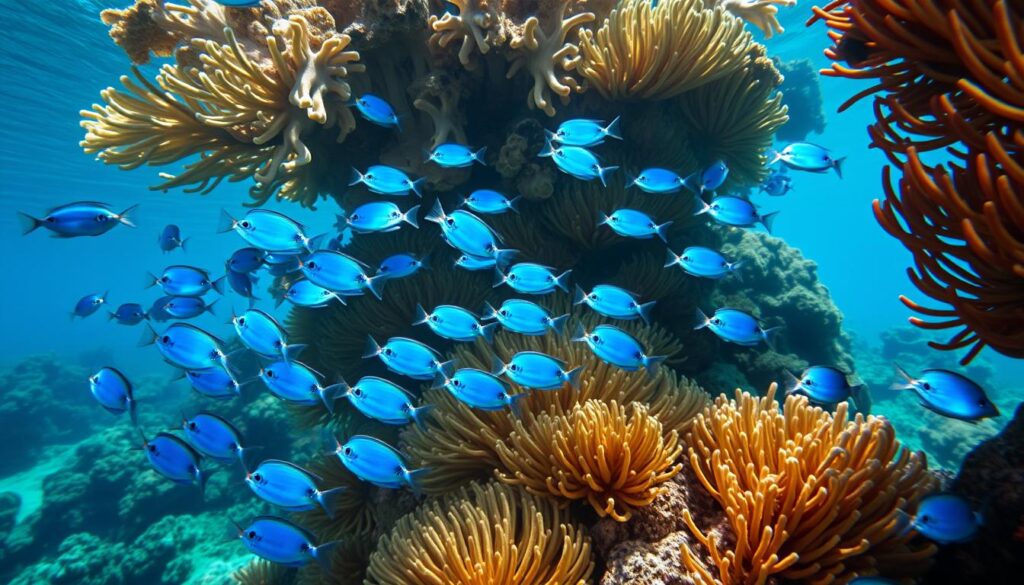
For those into underwater photography, the right dive gear rental is key. It can make a big difference in getting stunning images. Professional photographers suggest specific equipment for the best results.
Essential Camera Equipment
- Waterproof camera housing
- Wide-angle or macro lens
- External strobe lights
- Color correction filters
Camera Settings for Underwater Success
| Setting | Recommended Value |
|---|---|
| Shutter Speed | 1/20th – 1/60th of a second |
| Aperture | F7 to F13 |
| ISO | 100-400 |
Best Practices for Damselfish Photography
Capturing damselfish needs patience and skill. The Great Barrier Reef, home to over 1,500 fish species, is a prime spot for underwater photography. Shoot in the morning or early afternoon when sunlight is best.
“The key to great underwater photography is understanding your subject and respecting their environment.” – Marine Photography Expert
When taking damselfish photos, keep a safe distance. This avoids disturbing their natural behavior. Use slow shutter speeds, between 1/10th to 1/20th of a second, to capture their movement while keeping the background sharp.
Ethical Photography Considerations
- Minimize underwater disturbance
- Never touch marine life
- Use dive gear rental that supports conservation
- Respect marine ecosystem boundaries
By following these tips, divers can create stunning damselfish photos. They also support marine conservation efforts.
The Role of Damselfish in Coral Reefs
Exploring coral reefs shows us the amazing connections in marine life. Damselfish are important for keeping the reef healthy. They do this through their special behaviors and how they work with other sea creatures.
These small fish are big helpers in saving the sea. They show us how all sea life is connected. This is key for keeping the ocean healthy.
Mutualism with Other Species
Damselfish have amazing friendships with other sea animals. These friendships help the whole reef:
- They live with sea anemones for protection
- They help anemones by cleaning up food
- They get safe from predators in return
Contribution to Reef Health
Damselfish do a lot to help the reef. They keep it healthy in many ways:
| Ecological Function | Impact |
|---|---|
| Algae Control | They eat algae to stop it from covering coral |
| Territory Management | They protect certain areas of the reef |
| Biodiversity Support | They help keep the ecosystem balanced |
“Damselfish are the unsung heroes of coral reef ecosystems, maintaining balance through their daily activities.” – Marine Biologist Research Team
Damselfish are not just colorful fish. They are also key to the reef’s health. Marine conservation is now focusing more on protecting these important fish.
Environmental Concerns
Marine conservation is key to protect marine ecosystems, like those of damselfish. Climate change is a big threat to these colorful reef dwellers. It could harm their homes and the reefs they live in.
Impact of Climate Change on Damselfish Populations
Warmer ocean temperatures are a big danger for damselfish homes. Coral reefs are changing fast because of the environment:
- Ocean temperatures increasing by 1°C above seasonal maximums
- Coral bleaching events reducing viable reef environments
- Decreased calcification rates in reef-building organisms
Conservation Strategies and Efforts
Scuba diving with damselfish helps in marine conservation. Divers can help by doing specific things:
- Participating in citizen science projects
- Supporting marine protected areas
- Practicing responsible underwater tourism
“Every dive is a chance to protect and understand our marine ecosystems.” – Marine Biologist
Studies show that focused conservation can help damselfish a lot. Important actions are needed to keep coral reefs healthy.
Common Marine Species Found Alongside Damselfish
Diving with damselfish provides an opportunity to encounter a diverse array of marine species that share the same habitat. From colorful reef fish to fascinating invertebrates, here are some common marine species you may encounter alongside damselfish during your underwater explorations:
- Clownfish: Perhaps the most famous companion of damselfish is the clownfish, also known as anemonefish. These small, brightly colored fish form a symbiotic relationship with sea anemones, seeking shelter among their tentacles and providing protection in return. Clownfish and damselfish often inhabit the same coral reef areas, creating a harmonious coexistence.
- Butterflyfish: Butterflyfish are known for their striking colors and delicate, butterfly-like appearance. They are often found alongside damselfish in coral reef ecosystems. These graceful fish feed on coral polyps and small invertebrates, showcasing their vibrant hues as they gracefully glide through the water.
- Surgeonfish: Surgeonfish, also known as tangs, are characterized by their sharp, blade-like spines near their tails. They are frequently seen swimming alongside damselfish, particularly in reef areas abundant with algae. Surgeonfish play a vital role in maintaining the health of coral reefs by grazing on algae, and their presence adds to the visual richness of the underwater environment.
- Angelfish: Angelfish are renowned for their striking colors and unique body shapes. These graceful swimmers can often be found in the vicinity of damselfish, adding to the vibrant tapestry of the reef ecosystem. The beauty of angelfish, coupled with their distinct behaviors, makes them a captivating sight for divers.
- Wrasse: Wrasse are a diverse group of fish known for their colorful patterns and behaviors. These active swimmers can be found alongside damselfish, often foraging among the reef for small invertebrates and crustaceans. With their vibrant colors and engaging behaviors, wrasse contribute to the dynamic and lively atmosphere of the underwater world.
- Sea Turtles: Encounter with sea turtles is a highlight of any diving experience. These majestic creatures can often be spotted gliding gracefully through the water alongside damselfish. Observing their serene movements and sharing their underwater realm is an awe-inspiring experience that leaves a lasting impression.
- Moray Eels: Moray eels are fascinating creatures that often inhabit crevices and rocky areas of the reef. Their sinuous bodies and powerful jaws make them formidable predators. Alongside damselfish, moray eels add a sense of intrigue and mystery to the underwater landscape.
- Invertebrates: The coral reefs that damselfish call home are teeming with a variety of invertebrates. From colorful sea fans and sponges to intricate coral formations, the reef is a haven for countless species. Anemones, crabs, shrimp, and nudibranchs are just a few examples of the diverse invertebrates that coexist with damselfish, creating a captivating underwater ecosystem.
Encountering these common marine species alongside damselfish adds depth and richness to your diving experience. Each encounter provides a unique opportunity to witness the intricate relationships and interconnectedness of marine life within their shared habitat.
Remember, as you observe and interact with these species, it’s essential to maintain a respectful distance and minimize disturbances to their natural behaviors. By approaching them with care and respect, you can appreciate their beauty while ensuring the preservation of their fragile environment.
Conclusion: Your Next Scuba Adventure
Diving with damselfish opens a window to an extraordinary underwater world. It captivates both novice and experienced divers. Your tropical vacation can turn into an unforgettable marine exploration with scuba certification.
The journey of discovering damselfish starts with understanding their unique behaviors. These small but fascinating creatures show the balance of underwater life. Scuba certification unlocks these remarkable underwater experiences.
Encouragement for New Divers
Professional diving instructors with 27 years of experience suggest starting with training programs. Learning proper diving techniques lets you explore depths where damselfish thrive. Your tropical vacation can become an educational adventure that connects you with marine ecosystems.
Final Thoughts on Damselfish and Diving
Whether you see the 4-7.5 inch Yellowtail Damselfish or explore diverse marine environments, each dive is special. Embrace responsible diving practices, respect marine life, and get ready for an extraordinary journey beneath the waves.
FAQ – Diving with Damselfish
What are damselfish, and why are they interesting to divers?
Damselfish are small, colorful fish found in tropical coral reefs. They’re interesting to divers because of their bright colors and territorial behavior. These fish play a big role in keeping reefs healthy, making them fun to explore underwater.
Do I need special certification to dive with damselfish?
You don’t need a special certification just for damselfish. But, you should have a basic scuba certification like PADI Open Water. If you’re new, consider a course that teaches coral reef diving and observing marine life.
What equipment do I need for diving with damselfish?
You’ll need a wetsuit, mask, fins, regulator, and dive computer. If you want to take pictures, get an underwater camera with a housing. Many dive shops rent out gear, so you don’t have to buy everything.
Where are the best locations to see damselfish?
The best places are Raja Ampat in Indonesia, the Great Barrier Reef in Australia, and the Caribbean. The Pacific Ocean also has great spots. These areas have lots of damselfish and good diving conditions.
Are damselfish dangerous to divers?
No, they’re not dangerous. Damselfish can be territorial and might act aggressively, but they’re not a threat to humans. They might even swim up to divers, making for a fun underwater experience.
Can I see damselfish while snorkeling?
Yes! Damselfish live in shallow waters, so snorkelers can see them easily. Look for coral reefs near shorelines in tropical places for a chance to see these colorful fish without diving deep.
How can I contribute to damselfish conservation?
To help, dive responsibly by keeping a safe distance and not touching coral or marine life. Use reef-safe sunscreen and support marine conservation groups. Some dive operators have programs where you can help with research.
What time of year is best for diving with damselfish?
The best time varies by location, but tropical spots are good all year. Consider water temperature, visibility, and local breeding seasons when planning your dive.
Do I need special photography equipment to capture damselfish?
You don’t need professional gear to take great damselfish photos. Compact digital cameras with underwater housings work well. Some dive shops rent out camera gear, so you can capture your dive without spending a lot.
Are damselfish endangered?
Not all damselfish are endangered, but many face threats like climate change and habitat loss. Supporting conservation and diving responsibly can help protect these important fish.
